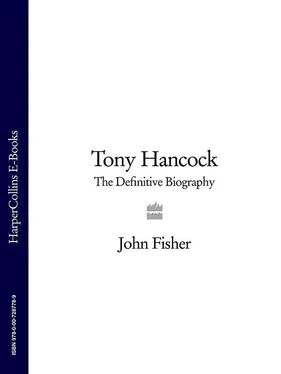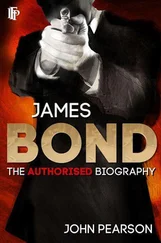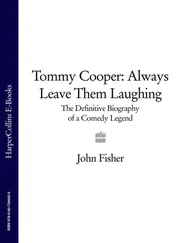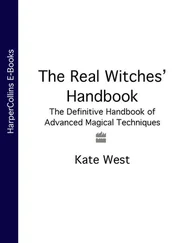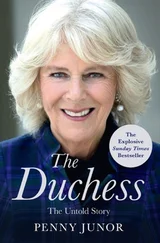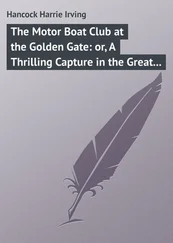The Definitive Biography
John Fisher

For Sue,
with love,
for always being there
FOREWORD TONY HANCOCK The Definitive Biography John Fisher
Sid James used to claim that he learned his lines during the television commercials. That was always a sore point with me, a plodder who takes about three hours to learn one page. All the time I sweated over my own script, going through what I call my hair shirt routine, I imagined Sid looking up from a cornflakes advertisement and saying, ‘Hmm … yes, I’ve got that,’ and I could have killed him.
I shall always remember the day I went to Pinewood to watch him playing a part in Chaplin’s picture A King in New York . He had a foolscap page and a half of dialogue to learn. He handed it to me and said, ‘Give us a run through, will you?’ I rehearsed it with him a couple of times and by then he was word perfect.
I was lucky to get on the set at all. Chaplin liked to work on his film behind locked doors and it was a long time before his production assistant would admit me into the fortress. All I wanted to do was to watch a genius at work, and seeing A King in New York come to life under that man’s magic touch was an unforgettable experience. His vitality was astounding. He seemed to be everywhere at once, directing a scene here, playing in one there, and never sitting down for a moment.
Now there is a man who knew all along exactly where he wanted to go and got there. Without aspiring to be another Chaplin, I hope I shall be able to look back on my career and say the same.
Tony Hancock, 1962
Preface TONY HANCOCK The Definitive Biography John Fisher
‘REMEMBERED LAUGHTER’ TONY HANCOCK The Definitive Biography John Fisher
‘ For a comedian to leave behind that kind of echo of remembered laughter – it is hard to think of his life as a complete tragedy. ’ Denis Norden
He would have relished the fact that by Coronation Year his name had been immortalised in a dirty joke. As a performer he renounced smut at an early age, but years later my school playground rallied to the cheeky charade of which his idol, Max Miller, would have been proud. Four deft pats on their respective body parts posed the question – ‘Who’s this?’ – and said it all. ‘Toe – knee – han’ – cock!’ The playground, then as now, knew no taboos. We all performed it out of bravado. And it is reassuring to learn that while he never allowed his professional funny side to stray into the double entendre terrain of seaside comic postcards colonised by the great Maxie himself, nevertheless from an early age ‘the lad himself’ would have been at the harmless vanguard of such fun.
I had the edge over the other members of my peer group in that I had seen our eponymous hero with my own two eyes. Hancock first became crystallised in the national consciousness by the radio comedy series, Educating Archie , starring ventriloquist Peter Brough and his dummy Archie Andrews. No sooner had the programme taken wing than Brough was touring the variety theatres with a stage show capitalising on its success. In November 1951 the pair arrived to spend a week at my local theatre, the Gaumont in Southampton. To a small child fast approaching seven years of age Archie was a real live boy, as genuine as any who would share that playground joke a year or so later. I prevailed upon my parents to take me to see my idol in the ‘flesh’. The parade of acts that preceded Brough’s ventriloquial turn stays etched in my memory to this day: Ossie Noble, a clown of antic finesse, able to fling an unruly deckchair across the stage in such a way that it stopped just short of the wings in perfect sitting position; Edward Victor, a hand shadow artist who secured the biggest applause of the evening with his pièce de résistance , a silhouette of Winston Churchill puffing at his cigar; Ronald Chesney, a virtuoso harmonica player with the uncanny knack of making his instrument talk; and a young girl singer hitting the high notes with, I now realise, a vocal control unusual for her years, Julie Andrews. The last two were regular members of the radio cast, as was the comedian on the bill, Tony Hancock.
It seems appropriate now that, on the show that introduced me to the delights and serendipity of variety, he should be there. Outside of the pantomime, he was the first comedian I saw perform on a theatre stage, and he set the standard thereafter. To those whose memory of Hancock is geared to his later Hancock’s Half Hour success, this performance would have been a total surprise, a triumph of visual athleticism as he threw himself into a series of impersonations of the sportsmen who featured in the opening titles of the Gaumont British Newsreel , preceded by a display of miming skill as he jerked and contorted his hands and arms and legs into an impression of an increasingly rampant robot to illustrate the song he was singing. When a few years later the theatre critic Kenneth Tynan outlined his concept of high-definition performance, he might have had Hancock in mind, although at the time all I cared about as he created physical patterns that seemed to linger in the air was the pain of laughter in my side.
Personal experience tells me that our favourite funny men inspire a loyalty that other entertainers seldom achieve. As Hancock’s career gathered momentum and prestige, he came to define the era of his greatest success – my childhood and teen years – with almost Proustian exactness, while his comparative fall from critical grace during the 1960s seemed to make its own comment upon a harsher and more cynical world. Only something transcending mere nostalgia can account for the emotional tug of war that his staunchest fans experienced as we observed the highs and lows of his career. When the slide set in, comedy – however brilliant Howerd and Steptoe and Pete & Dud proved to be – never seemed the same again. One was always waiting for Hancock to dazzle in a way that would cap the achievements of his rivals, but it never truly came. When I heard the news of his death in the summer of 1968, the hollowness of the moment seemed to say that we, his public, had failed him, that he had never been repaid for the great years. This book is an attempt to redress that debt.
Of the volumes produced on the life and work of Tony Hancock in the years following his demise, none has possibly made the impact of the first, a memoir by his second wife, Freddie Ross Hancock, written in association with that astute journalist David Nathan and published a stark year after his death. Temporarily the book, a frank and honest account of the troubles that beset the comedian down the years as well as a wider biographical treatment, turned its subject into basest clay. Emerging from a sheltered childhood protected by the enduring love of my parents’ marriage, I experienced the chill of disappointment to discover that the man I revered had been possessed by unconsidered demons. His apparent inconsiderateness and cruelty, awash in the dregs of an alcoholic despair, were nothing if not distressing to me at so impressionable an age. The book had been a gift from my parents and I recall wanting to keep it from them, so sensitive was I to the alienating aspects of its subject as he was depicted therein.
Maturity teaches that there exist the two clichéd sides to any story. In time I discovered that all star performers are marionettes whose strings are drawn upwards by the public’s expectation of them, whether on stage or off.
Читать дальше
